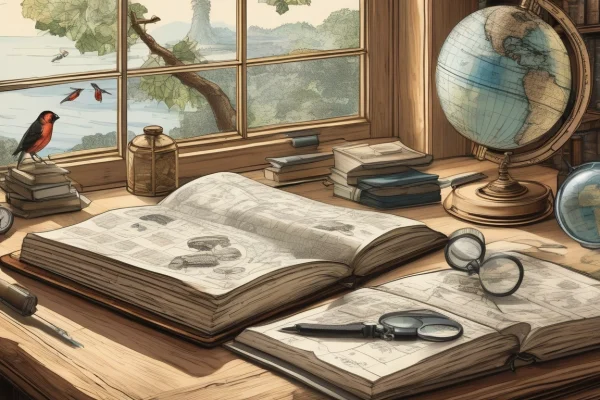Who Inspired the Theory of Evolution?

- Who Inspired the Theory of Evolution?
- Charles Darwin's Groundbreaking Work
- Alfred Russel Wallace's Contributions
- Jean-Baptiste Lamarck's Early Theories
- Thomas Malthus and Population Dynamics
- Gregor Mendel and Genetics
- Fossil Record and Transitional Forms
- Modern Synthesis of Evolutionary Biology
- Influence of Paleontology on Evolutionary Theory
- Impact of Evolutionary Theory on Society
- Future Directions in Evolutionary Research
- Frequently Asked Questions
The theory of evolution is one of the most profound concepts in science, shaping our understanding of life on Earth. But have you ever wondered who inspired this groundbreaking theory? The journey to uncover the origins of evolutionary thought is filled with fascinating figures and ideas that have left an indelible mark on biology and society.
At the heart of this evolution narrative is Charles Darwin, whose seminal work, On the Origin of Species, introduced the world to the concept of natural selection. His voyage aboard the HMS Beagle allowed him to observe diverse species, leading to insights that would revolutionize biology. But Darwin wasn’t alone in this intellectual quest; he shared the stage with other pivotal thinkers.
Consider Alfred Russel Wallace, often overshadowed by Darwin. Wallace independently formulated the idea of natural selection while exploring the rich biodiversity of the Amazon and the Malay Archipelago. His findings not only supported Darwin’s theories but also emphasized the importance of observation in scientific inquiry.
Before Darwin and Wallace, there was Jean-Baptiste Lamarck, who proposed the inheritance of acquired characteristics. Although his ideas were later challenged, they ignited discussions that paved the way for evolutionary thought. This shows how early theories can lay the groundwork for future discoveries, even if they are eventually disproven.
Another significant influence came from Thomas Malthus, whose essay on population dynamics highlighted the struggle for existence. Malthus’s ideas about resource limitations were instrumental in shaping Darwin’s understanding of natural selection. His work illustrated that life is a constant battle for survival, a theme that resonates throughout evolutionary biology.
To better understand how these ideas interconnect, let’s take a look at the following table summarizing key figures and their contributions:
| Influential Figure | Key Contribution |
|---|---|
| Charles Darwin | Natural Selection |
| Alfred Russel Wallace | Independently conceived natural selection |
| Jean-Baptiste Lamarck | Inheritance of acquired characteristics |
| Thomas Malthus | Population dynamics and struggle for existence |
As we delve deeper into the evolution narrative, it becomes clear that the theory is not just a product of one mind but a tapestry woven from the insights of many. Each contributor brought unique perspectives that challenged existing beliefs and opened new avenues for exploration. The story of who inspired the theory of evolution is a testament to the collaborative nature of scientific discovery.
Charles Darwin’s Groundbreaking Work
Charles Darwin is often regarded as the father of evolutionary biology, and his work has had an indelible impact on our understanding of life on Earth. In 1859, he published his seminal book, On the Origin of Species, which introduced the revolutionary concept of natural selection. This idea posits that species evolve over time through a process where advantageous traits become more common in a population due to their benefits in survival and reproduction. Imagine a race where only the fastest runners get to pass on their genes—this is the essence of Darwin’s theory.
Darwin’s journey aboard the HMS Beagle was pivotal. During this voyage, he meticulously observed various species across the globe, particularly in the Galápagos Islands. His observations led him to recognize patterns of adaptation that were astonishing. For instance, he noted how finches with different beak shapes thrived on different islands, each adapting uniquely to their environments. This realization was a spark that ignited the flame of evolutionary thought.
| Key Observations from the HMS Beagle | Significance |
|---|---|
| Variations in finch beak shapes | Illustrated adaptation to food sources |
| Species distribution across islands | Supported the idea of common descent |
| Fossil evidence of extinct species | Demonstrated change over time |
Darwin’s theory was not without controversy. Many at the time clung to traditional beliefs about creation, making his ideas a hotbed for debate. However, the evidence he presented was compelling. As he famously stated, “It is not the strongest of the species that survive, nor the most intelligent, but the one most responsive to change.” This quote encapsulates the essence of his groundbreaking work and its lasting legacy.
In summary, Darwin’s contributions laid the groundwork for the modern understanding of evolution, challenging us to rethink our place in the natural world. His insights continue to inspire scientists and thinkers alike, proving that the quest for knowledge is an ever-evolving journey.
On the Origin of Species
is not just a book; it’s a revolutionary piece of work that transformed our understanding of biology and the natural world. Published in 1859, Darwin’s masterpiece introduced the concept of natural selection, a mechanism that explains how species evolve over time. Imagine being on a ship, the HMS Beagle, sailing through uncharted territories, observing the diverse flora and fauna. Each observation was a puzzle piece, culminating in a theory that would challenge the very fabric of societal beliefs.
Darwin meticulously documented his findings, and his ideas were radical for his time. He proposed that species are not fixed; instead, they adapt and change in response to their environment. This was a game-changer! It suggested that humans share a common ancestor with other living beings, sparking debates that resonate even today.
| Key Concepts in Darwin’s Work | Description |
|---|---|
| Natural Selection | The process where organisms better adapted to their environment tend to survive and produce more offspring. |
| Variation | Differences among individuals in a population that can be inherited. |
| Survival of the Fittest | The idea that only those organisms best suited to their environment will survive and reproduce. |
However, Darwin was not alone in his quest for understanding evolution. His work was built on the shoulders of giants, such as Thomas Malthus, whose essay on population dynamics highlighted the struggle for existence, influencing Darwin’s perspective. Additionally, Darwin’s ideas were enriched by the earlier theories of Jean-Baptiste Lamarck, who proposed that organisms could pass on traits acquired during their lifetime.
In summary, was a pivotal moment in scientific history, challenging the status quo and opening the door to modern evolutionary biology. Its impact continues to be felt across various fields, from genetics to ecology, and it remains a cornerstone in the understanding of life on Earth.
laid the foundation for evolutionary biology, introducing natural selection as a mechanism for evolution. His observations during the HMS Beagle voyage were pivotal in formulating his theories.
This article explores the key figures and ideas that shaped the development of the theory of evolution, highlighting their contributions and the impact they had on science and society.
Charles Darwin, a name synonymous with the theory of evolution, laid the foundation for evolutionary biology through his groundbreaking work, On the Origin of Species. This pivotal book introduced the concept of natural selection as a mechanism for evolution, a revolutionary idea that changed the way we understand life on Earth. But how did he arrive at such a profound conclusion? The answer lies in his remarkable observations during the HMS Beagle voyage.
During this expedition, which lasted from 1831 to 1836, Darwin meticulously cataloged a plethora of species across various environments. His keen eye for detail and passion for discovery led him to notice intriguing patterns, such as:
- The variation of species in different geographical locations.
- The adaptation of organisms to their specific environments.
- The striking similarities and differences between species on the Galápagos Islands.
These observations were not just casual notes in a travel diary; they were the seeds that would grow into the revolutionary theory of evolution. For instance, Darwin’s studies of the finches on the Galápagos Islands revealed how different beak shapes corresponded to available food sources, illustrating the concept of adaptation. It was as if he had stumbled upon nature’s own blueprint for survival!
Moreover, Darwin’s insights were further enriched by the ideas of other thinkers of his time, such as Thomas Malthus, who discussed the struggle for existence. This, combined with Darwin’s findings, painted a vivid picture of a world where only the fittest survive. His work not only challenged the prevailing views of creation but also sparked a wave of scientific inquiry that continues to this day.
| Key Observations | Significance |
|---|---|
| Variation among species | Led to understanding of adaptation and survival. |
| Geographical distribution | Highlighted the role of environment in evolution. |
| Fossil evidence | Provided historical context for species development. |
In conclusion, Darwin’s voyage on the HMS Beagle was not just a journey across the globe; it was a journey into the heart of biological science, where he unlocked the mysteries of evolution. His work remains a cornerstone of biological sciences, influencing countless fields and continuing to inspire new generations of scientists.
Alfred Russel Wallace’s Contributions
Alfred Russel Wallace is often regarded as the unsung hero of evolutionary theory, standing in the shadows of Charles Darwin. However, his contributions were pivotal in shaping the understanding of natural selection. During his extensive travels through the Amazon and the Malay Archipelago, Wallace meticulously observed the diverse forms of life, which led him to independently formulate the theory of natural selection. Can you imagine the thrill of discovering a new species while traversing uncharted territories? Wallace did just that, and his findings were nothing short of revolutionary.
Wallace’s work culminated in a joint presentation with Darwin in 1858, where they both introduced their ideas to the Linnean Society of London. This moment was a landmark in the history of science, showcasing the power of collaboration and the importance of multiple perspectives in understanding complex ideas. Here’s a brief overview of his key contributions:
| Contribution | Description |
|---|---|
| Natural Selection | Independently proposed the mechanism of natural selection alongside Darwin. |
| Biogeography | Studied species distribution and its relation to the environment, leading to the concept of the Wallace Line. |
| Species Concept | Emphasized the importance of geographical isolation in species formation. |
Wallace’s insights didn’t just stop at natural selection. He also delved into the realm of biogeography, studying how geographical barriers influence species distribution. His concept of the Wallace Line—a boundary separating distinct faunal regions in Southeast Asia—illustrates how environmental factors shape evolutionary paths. This line is a testament to his keen observation skills and deep understanding of ecological dynamics.
In addition to his scientific endeavors, Wallace was a passionate advocate for social reform and environmental conservation. He believed that understanding evolution was crucial for addressing societal issues. As he famously said, “The more we learn about the world, the more we realize how interconnected everything is.” This holistic view not only enriched the field of biology but also emphasized the importance of preserving our natural world.
In conclusion, Alfred Russel Wallace’s contributions to the theory of evolution are monumental. His independent discovery of natural selection, coupled with his studies in biogeography, laid a foundation that continues to inspire scientists today. Wallace’s legacy serves as a reminder that sometimes, the most profound insights come from those working in the background.
Jean-Baptiste Lamarck’s Early Theories
Jean-Baptiste Lamarck was a pioneering figure in the realm of evolutionary thought, long before Charles Darwin made his groundbreaking contributions. Lamarck’s theories, particularly his idea of the inheritance of acquired characteristics, sparked significant discussions on how species adapt and evolve over time. Imagine a giraffe stretching its neck to reach higher leaves; Lamarck suggested that this stretched neck would be passed down to its offspring. While this concept has been largely discredited, it opened the door to new ways of thinking about evolution.
One of the most notable aspects of Lamarck’s work was his emphasis on the role of the environment in shaping organisms. He proposed that organisms could change during their lifetimes in response to environmental pressures, and these changes would be inherited by future generations. This idea, although flawed, was revolutionary for its time and laid the groundwork for future evolutionary theories.
| Theory | Description |
|---|---|
| Inheritance of Acquired Characteristics | Traits acquired during an organism’s life can be passed to offspring. |
| Use and Disuse | Body parts that are used become stronger, while those that are not used weaken. |
Despite the eventual rejection of many of his ideas, Lamarck’s work was crucial in moving the conversation about evolution forward. He was not afraid to challenge the status quo, and his theories encouraged others to explore the origins and adaptations of species. In fact, his ideas can be summarized in a few key points:
- Environment’s Role: Lamarck believed that environmental changes directly influenced organisms.
- Adaptation: He argued that organisms adapt to their surroundings over generations.
- Challenge to Creationism: His theories posed a significant challenge to the traditional views of creation.
In conclusion, while Lamarck’s theories may not have stood the test of time, his contributions were instrumental in shaping early evolutionary thought. They paved the way for future scientists, including Darwin, to build upon and refine the understanding of how life evolves. His willingness to explore the unknown remains a testament to the spirit of scientific inquiry.

Thomas Malthus and Population Dynamics
When we dive into the world of evolutionary theory, we can’t overlook the profound impact of Thomas Malthus. His ideas on population dynamics were like a spark that ignited the flames of natural selection in the minds of thinkers like Charles Darwin. Malthus, an English cleric and scholar, published his influential essay, An Essay on the Principle of Population, in 1798. In it, he argued that populations tend to grow exponentially, while resources such as food grow linearly. This fundamental imbalance leads to a struggle for existence, which is a cornerstone of Darwin’s theory of evolution.
Malthus’s insights can be summarized in a few key points:
- Exponential Growth: Populations can double in size rapidly if unchecked.
- Resource Limitations: Resources like food and space are finite, creating competition.
- Struggle for Existence: The competition for limited resources leads to natural selection.
This struggle, as Malthus described, is not just a theoretical concept; it’s a reality that shapes the survival of species. Imagine a vast garden where every plant is vying for sunlight and water. Only the strongest and most adaptable will flourish, while others wither away. This analogy mirrors Malthus’s observations, emphasizing how environmental pressures can dictate which individuals thrive and reproduce.
Furthermore, Malthus’s theories were not just academic musings; they had real-world implications. His ideas influenced not only Darwin but also the broader scientific community. They prompted discussions about social policy, economics, and even ethics. For instance, Malthus’s perspective on population control sparked debates about poverty and welfare, which are still relevant today.
| Key Concepts from Malthus | Impact on Evolutionary Thought |
|---|---|
| Population Growth | Foundation for natural selection |
| Resource Scarcity | Understanding of survival challenges |
| Struggle for Existence | Mechanism for evolutionary change |
In conclusion, Thomas Malthus’s exploration of population dynamics laid critical groundwork for the theory of evolution. His insights into the balance between population growth and resource availability not only influenced Darwin’s thinking but also continue to resonate in our understanding of biology and society today. As we explore the complexities of life on Earth, Malthus’s legacy reminds us that the struggle for survival is a universal theme that transcends time and species.
Gregor Mendel and Genetics
Gregor Mendel, often referred to as the father of genetics, made groundbreaking contributions that laid the foundation for our understanding of heredity. His meticulous experiments with pea plants in the mid-19th century revealed the fundamental principles of inheritance that would later complement Darwin’s theory of evolution. Mendel’s work was largely overlooked during his lifetime, but it became pivotal in the early 20th century when scientists rediscovered his findings, leading to the establishment of genetics as a scientific discipline.
Mendel’s experiments demonstrated how traits are passed from one generation to the next through discrete units, now known as genes. He identified dominant and recessive traits, which can be summarized in the following key concepts:
- Dominant Traits: Traits that manifest in the offspring even if only one parent contributes the gene.
- Recessive Traits: Traits that only appear when both parents contribute the gene.
- Segregation: The principle that alleles for a trait separate during gamete formation.
- Independent Assortment: The idea that genes for different traits can segregate independently during the formation of gametes.
To illustrate Mendel’s findings, the following table summarizes his experiments with pea plants:
| Trait | Dominant Allele | Recessive Allele |
|---|---|---|
| Seed Shape | Round (R) | Wrinkled (r) |
| Seed Color | Yellow (Y) | Green (y) |
| Flower Color | Purple (P) | White (p) |
Mendel’s work not only clarified how traits are inherited but also provided a mechanism that Darwin’s theory lacked. As Charles Darwin focused on the process of natural selection, Mendel offered a deeper understanding of how variations arise within populations. This synergy between Darwin’s and Mendel’s theories has profoundly shaped modern evolutionary biology, showcasing the intricate dance between genetics and evolution.
In conclusion, Mendel’s pioneering research established the groundwork for genetics, which has become an essential component of evolutionary theory. His legacy lives on, reminding us of the crucial link between genetics and evolution, and how understanding these principles can illuminate the complexities of life itself.

Fossil Record and Transitional Forms
The fossil record serves as a remarkable archive of Earth’s biological history, revealing a timeline of life that stretches back millions of years. Within this record, we find transitional forms—the missing links that showcase the gradual changes species undergo over time. These fossils not only provide evidence of evolution but also illustrate the intricate web of life that has existed on our planet.
One of the most famous transitional fossils is the Archaeopteryx, which exhibits features of both reptiles and birds. This iconic specimen has feathers like a bird but also retains teeth and a long bony tail, emphasizing the evolutionary connection between these two groups. The discovery of Archaeopteryx was a game-changer, as it validated Darwin’s theory of evolution by demonstrating how species can evolve through gradual modifications.
Here are some key transitional fossils that highlight the evolutionary process:
- Tiktaalik: A fish-like creature that showcases the transition from water to land, possessing both gills and lungs.
- Australopithecus: A hominid that bridges the gap between apes and modern humans, exhibiting both bipedalism and arboreal adaptations.
- Whale ancestors: Fossils like Pakicetus and Ambulocetus illustrate the evolution of whales from land-dwelling mammals.
These fossils are not just remnants of the past; they are vital clues that help scientists piece together the story of life on Earth. The fossil record provides a chronological sequence of how species have adapted to their environments over time, offering insights into the mechanisms of evolution.
In conclusion, the fossil record and its transitional forms serve as a powerful testament to the theory of evolution. They remind us that life is not static but rather a dynamic process shaped by natural selection and environmental changes. As we continue to uncover new fossils, we gain a deeper understanding of our planet’s biological heritage and the interconnectedness of all living things.
Modern Synthesis of Evolutionary Biology
The is a cornerstone of biological sciences, merging Darwin’s theory of natural selection with Mendelian genetics. This synthesis revolutionized our understanding of evolution, providing a robust framework that integrates various biological disciplines. Imagine trying to solve a complex puzzle; the Modern Synthesis brings together different pieces—genetics, paleontology, and ecology—into a cohesive picture of how life evolves over time.
One of the most significant aspects of this synthesis is how it reconciled the ideas of genetic variation and natural selection. Before this, many scientists struggled to see how traits were passed down through generations. With Gregor Mendel’s principles of inheritance, we gained insight into the mechanisms behind evolution, allowing us to understand how new traits emerge and spread within populations.
To illustrate the key components of the Modern Synthesis, consider the following table:
| Component | Description |
|---|---|
| Natural Selection | The process where organisms better adapted to their environment tend to survive and produce more offspring. |
| Genetic Drift | Random changes in allele frequencies in a population, which can lead to significant evolutionary changes over time. |
| Mutation | Changes in DNA sequences that create new genetic variations, serving as the raw material for evolution. |
| Gene Flow | The transfer of genetic material between populations, which can introduce new genetic variations. |
This synthesis also emphasized that evolution is not just a slow, gradual process but can occur in bursts through mechanisms like punctuated equilibrium. This idea, proposed by paleontologists Stephen Jay Gould and Niles Eldredge, suggests that species remain relatively unchanged for long periods, interrupted by brief episodes of rapid change.
In conclusion, the has profoundly shaped our understanding of life on Earth. It has provided a comprehensive framework that continues to guide research and discussions in evolutionary biology today. As we delve deeper into genetics and explore new dimensions of evolution, this synthesis remains a pivotal reference point, reminding us of the intricate dance between life’s complexity and its underlying simplicity.
Influence of Paleontology on Evolutionary Theory
Paleontology, the study of ancient life through fossils, has played a crucial role in shaping our understanding of evolutionary theory. By examining the remnants of long-extinct organisms, paleontologists have provided invaluable insights into the history of life on Earth. The fossil record acts as a time capsule, revealing how species have changed and adapted over millions of years. This field not only supports the principles laid out by early evolutionary thinkers but also enriches our comprehension of the intricate web of life.
One of the most significant contributions of paleontology to evolutionary theory is the discovery of transitional forms. These fossils serve as a bridge between different groups of organisms, illustrating the gradual changes that occur over time. For instance, the famous Archaeopteryx fossil highlights the evolutionary link between reptiles and birds, showcasing features of both groups. Such findings have reinforced the idea that species are not static but rather dynamic entities that evolve in response to their environments.
To better understand the impact of paleontology on evolutionary theory, consider the following key points:
- Evidence of Common Ancestry: Fossils reveal patterns of descent and common ancestry among species.
- Insights into Extinction Events: Paleontologists study mass extinction events, providing context for the survival and adaptation of species.
- Evolutionary Trends: The fossil record illustrates trends such as increasing complexity and specialization in various lineages.
Furthermore, paleontological discoveries have sparked debates and inquiries that challenge and refine existing evolutionary theories. For example, the discovery of unexpected fossils can lead to new questions about the timing and nature of evolutionary changes. As noted by renowned paleontologist Stephen Jay Gould, “The absence of fossil evidence for intermediary stages between major transitions in organic design is a nagging problem for gradualism.” This quote encapsulates the ongoing dialogue between paleontology and evolutionary theory, highlighting the necessity of continuous research and exploration.
In conclusion, the influence of paleontology on evolutionary theory is profound and multifaceted. As researchers continue to unearth ancient remains, they not only illuminate the past but also pave the way for a deeper understanding of the mechanisms driving evolution. The interplay between fossil evidence and evolutionary concepts remains a vibrant field of study, promising new discoveries that will further enrich our grasp of life’s history.
Impact of Evolutionary Theory on Society
The theory of evolution has not only reshaped our understanding of biology but has also profoundly influenced various aspects of society. Its implications stretch beyond the realm of science, challenging traditional beliefs and sparking debates that continue to resonate today. The ripple effects of evolutionary thought can be seen in numerous fields, including psychology, sociology, and even ethics.
One of the most significant impacts of evolutionary theory is its challenge to religious and philosophical views on the origin of life. The idea that humans share a common ancestor with other species has led to a reevaluation of humanity’s place in the natural world. This has prompted discussions around morality, human behavior, and the very nature of existence. For instance, many have questioned how evolutionary principles align with religious teachings, leading to ongoing debates in both educational and religious institutions.
Furthermore, evolutionary theory has influenced public policy and education. In many countries, the teaching of evolution in schools has become a contentious issue, often pitting scientific understanding against religious beliefs. This conflict has led to significant legal battles, as communities grapple with how to present this fundamental aspect of science to future generations.
| Field | Impact of Evolutionary Theory |
|---|---|
| Psychology | Understanding of human behavior through evolutionary lenses. |
| Sociology | Insights into social structures and human interactions. |
| Ethics | Debates on morality and ethical behavior influenced by evolutionary principles. |
In addition to its academic influence, evolutionary theory has also affected popular culture. Books, movies, and documentaries have brought the concepts of evolution into mainstream consciousness, often sparking curiosity and discussion among the general public. For example, films that depict evolutionary themes have led to a greater appreciation of biodiversity and conservation efforts.
In summary, the impact of evolutionary theory on society is immense and multifaceted. It continues to challenge our understanding of life, prompting us to consider profound questions about our origins and our future. As we move forward, embracing this knowledge can lead to a more informed and enlightened society.

Future Directions in Evolutionary Research
The field of evolutionary research is constantly evolving, much like the species it studies. As we delve deeper into the mysteries of life, new technologies and methodologies are reshaping our understanding of evolution. One exciting area of focus is evolutionary developmental biology, often referred to as “evo-devo.” This discipline examines how evolutionary processes influence developmental pathways, shedding light on how organisms adapt over time.
Another promising direction is the integration of genomics into evolutionary studies. With advancements in DNA sequencing technologies, researchers can now analyze genetic variations across species at an unprecedented scale. This not only enhances our understanding of evolutionary mechanisms but also allows scientists to trace back the lineage of organisms with greater accuracy. For instance, studies in genomics have revealed surprising connections between seemingly unrelated species, challenging traditional classifications.
Furthermore, the role of environmental factors in evolution is gaining traction. As climate change and habitat destruction accelerate, understanding how species adapt to rapidly changing environments is crucial. Researchers are increasingly focusing on phenotypic plasticity, which refers to an organism’s ability to change its phenotype in response to environmental conditions. This could provide insights into how species might cope with future challenges.
| Research Area | Description | Impact |
|---|---|---|
| Evolutionary Developmental Biology | Studies the relationship between evolution and developmental processes. | Enhances understanding of organismal adaptations. |
| Genomics | Analyzes genetic variations across species. | Refines lineage tracing and evolutionary connections. |
| Phenotypic Plasticity | Explores how organisms adapt morphologically and physiologically. | Offers insights into adaptation to environmental changes. |
In conclusion, the future of evolutionary research is bright and full of potential. As we embrace new technologies and interdisciplinary approaches, we not only deepen our understanding of evolution but also prepare ourselves to face the challenges posed by a changing world. The question remains: how will these advancements shape our perception of life itself? Only time will tell, but one thing is for sure—evolution is an ongoing story, and we’re all part of it.
Frequently Asked Questions
- What is the theory of evolution?
The theory of evolution explains how species change over time through processes like natural selection and genetic variation. It suggests that all living organisms share a common ancestor and have adapted to their environments over millions of years.
- Who were the key figures in the development of the theory of evolution?
Key figures include Charles Darwin, who introduced natural selection; Alfred Russel Wallace, who independently conceived similar ideas; and Gregor Mendel, whose work on genetics provided a foundation for understanding heredity.
- How did Darwin’s observations influence his theory?
Darwin’s observations during his voyage on the HMS Beagle, particularly in the Galapagos Islands, revealed variations among species that led him to propose natural selection as a mechanism for evolution.
- What role does the fossil record play in evolution?
The fossil record provides crucial evidence of how species have changed over time, showcasing transitional forms that link different species, such as the famous Archaeopteryx, which illustrates the connection between reptiles and birds.
- How has evolutionary theory impacted society?
Evolutionary theory has influenced various fields, including psychology and sociology, challenging traditional beliefs about human origins and morality, and sparking debates about the nature of life itself.
- What is the modern synthesis of evolutionary biology?
The modern synthesis integrates Darwinian evolution with Mendelian genetics, creating a comprehensive framework that reconciles various biological disciplines and solidifies the scientific acceptance of evolution.





